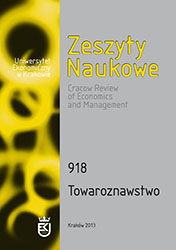Ocena możliwości zastosowania analizy lotnych związków organicznych do detekcji aktywności mikrobiologicznej na przykładzie badań przeprowadzonych w Muzeum Narodowym w Krakowie
Słowa kluczowe:
MLZO, chromatografia gazowa, grzyby pleśniowe, skażenie mikrobiologiczneAbstrakt
W ramach badań lotnych związków organicznych (LZO) w powietrzu wybranych pomieszczeń Muzeum Narodowego w Krakowie przeprowadzono ocenę możliwości zastosowania analizy tych związków do detekcji aktywności mikrobiologicznej grzybów pleśniowych. Podstawowym założeniem przyjętym w tej metodzie jest możliwość wykrycia obecności pleśni w określonym miejscu na podstawie zidentyfikowanych w powietrzu tzw. mikrobiologicznych lotnych związków organicznych (MLZO), które są emitowane przez grzyby do otoczenia. Taka analiza eliminuje potrzebę prowadzenia klasycznych, długotrwałych analiz mikrobiologicznych. Zestawienie wyników badań LZO oraz analiz mikrobiologicznych w połączeniu z danymi literaturowymi pozwoliło udowodnić, że w przypadku zbadanych pomieszczeń istnieje zależność między zidentyfikowanymi w nich gatunkami pleśni a MLZO obecnymi w powietrzu. Potwierdza to możliwość zastosowania badań tych związków do detekcji aktywności mikrobiologicznej, przy czym metodyka tych badań wymaga dopracowania.Downloads
Bibliografia
ASHRAE [2007], Museums, Libraries and Archives (chapter 21), in 2007 ASHRAE handbook: Heating, Ventilating, and Air-conditioning Applications, SI ed., American Society of Heating, Refrigerating and Air-conditioning Engineers, Inc.
Barański A. et al. [2001], Effect of Relative Humidity on the Degradation Rate of Cellulose. The Methodology Studies, Proceedings from Symposium „Degradation of Paper and Cellulose", EMRS Spring Meeting, Strasbourg.
Betancourt D.A. et al. [2013], Microbial Volatile Organic Compound Emissions from Stachybotrys Chartarum Growing on Gypsum Wallboard and Ceiling Tile, „BMC Microbiology", vol. 13.
Camuffo D. et al. [2001], Environmental Monitoring in Four European Museums, „Atmospheric Environment", vol. 35.
Canhoto O. et al. [2004], Application of Electronic Nose Technology for the Detection of Fungal Contamination in Library Paper, „International Biodeterioration and Biodegradation", vol. 54.
EPA MO T-17 [1999], Compendium Method TO-17, Determination of Volatile Organic Compounds in Ambient Air Using Active Sampling Onto Sorbent Tubes, Canter for Environmental Research, Information Office of Research and Development, U.S. Environmental Protection Agency, Cincinnati, OH 45268.
Fiedler K., Schütz E., Geh S. [2001], Detection of Microbial Volatile Organic Compounds (MVOCs) Produced by Moulds on Various Materials, „International Journal of Hygiene and Environmental Health", vol. 204.
Florian M.L. [2002], Fungal Problem Assessment, Monitoring Methods, and Interpretation of Result Pertaining to Air Quality and Potential Contamination of Collections [w:] Art, Biology, and Conservation: Biodeterioration of Works of Art, eds. R.J. Koestler et. al, Metropolitan Museum of Art Series, New York.
Gutnarowska B., Piotrowska M. [2007], Methods of Mycological Analysis in Buildings, „Building and Environment", vol. 42.
Haillant O., Fromageot D., Lemaire J. [2005], Experimental Techniques in Studies of Photo-stability [w:] Ageing and Stabilization of Paper, eds. M. Strlič, J. Kolar, Lublana.
Havermans J. [1994], The Effects of Air Pollutants on the Accelerated Ageing of Cellulose Containing Materials - Paper, STEP PROJECT CT 90-0100, Final Report. TNO/EC DG XII, Delft.
Hess-Kosa K. [2002], Indoor Air Quality - Sampling Methodologies, Lewis Publisher, Boca Raton, FL.
Korpi A. et al. [1997], Microbial Growth and Metabolism in House Dust, „International Biodeterioration and Biodegradation", vol. 40.
Kuske M., Romain A.C., Nicolas J. [2005], Microbial Volatile Organic Compounds as Indicators of Fungi. Can an Electronic Nose Detect Fungi in Indoor Environments?, „Building and Environment", vol. 40.
Lancker F. et al. [2008], Use of Headspace SPME-GC-MS for the Analysis of the Volatiles Produced by Indoor Molds Grown on Different Substrates, „Journal of Environmental Monitoring", vol. 10.
Lavine B.K. [2012], Prediction of Mold Contamination from Microbial Volatile Organic Compound Profiles using Solid Phase Microextraction and Gas Chromatography/mass Spectrometry, „Microchemical Journal", vol. 103.
Martens M. [2012], Climate Risk Assessment in Museums: Degradation Risks Determined from Temperature and Relative Humidity Data, PhD thesis, Technishe Universiteit Eindhoven.
Matysik S., Herbarth O., Mueller A. [2008], Determination of Volatile Metabolites Originating from Mould Growth on Wall Paper and Synthetic Media, „Journal of Microbiological Methods", vol. 75.
Mycoteam [2007], Raport dostarczony drogą elektroniczną przez Mycoteam i udostępniony przez pracowników LABNOZ - Muzeum Narodowego w Krakowie.
Nielsen K.F. [2003], Mycotoxin Production by Indoor Molds, „Fungal Genetics and Biology", vol. 39.
Pasanen A.L. et al. [1998], Critical Aspects on the Significance of Microbial Volatile Metabolites an Indoor Air Pollutants, „Environmental International", vol. 24, nr 7.
Pluschke P. [2004], Indoor Air Pollution, The Handbook of Environmental Chemistry, Springer.
Polizzi V. et al. [2012], Influence of Various Growth Parameters on Fungal Growth and Volatile Metabolite Production by Indoor Molds, „Science of the Total Environment", vol. 414.
Sunesson A.L. et al. [1996], Volatile Metabolites Produced by Two Fungal Species Cultivated on Building Materials, The Annals of Occupational Hygiene, vol. 40, nr 4
Szostak-Kot J., Sygula-Cholewinska J. [2010], Microbial Risks for Museum Objects During Storage, 18th IGWT Symposium, Accademia Italiana di Scienze Merceologiche - AISME, Proceedings from Symposium, Roma.
Thomson G. [1994], The Museum Environment, eds. A. Oddy, D. Lintrum, 2nd ed., Butterworth-Heinemann series in conservation and museology, Oxford.
Wady L. et al. [2003], Use of Gas Chromatography - Mass Spectrometry/solid Phase Microextraction for the Identification of MVOCs from Moldy Building Materials, „Journal of Microbiological Methods", vol. 52(3).
Wilkins K., Larsen K. [1995], Variation of Volatile Organic Compound Patterns of Mold Species from Damp Buildings, „Chemosphere", vol. 31, nr 5,
Wilkins K., Larsen K., Simkus M. [2000], Volatile Metabolites from Mold Growth on Building Materials and Synthetic Media, „Chemosphere", vol. 41, nr 3.
Wolkoff P., Nielsen G.D. [2001], Organic Compounds in Indoor Air - their Relevance for Perceived Indoor Air Quality, „Atmospheric Environment", vol. 35(26).
Zou X., Uesaka T., Gurnagul N. [1996], Prediction of Paper Permanence by Accelerated Aging I. Kinetic Analysis of the Aging Process, „Cellulose", vol. 3.




